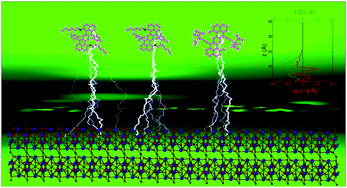Molecular functionalization of all-inorganic perovskite CsPbBr3 thin films†
Abstract
Well-defined heterointerface formation between low bandgap π-conjugated organic materials and all-inorganic perovskites is desirable for the advancement of physical, chemical, and electronic interactions in solar-cell devices. Herein, we investigate the charge carrier dynamics and optical responses across three representative functionalized-heptazetherene molecules on CsPbBr3 thin films using synchrotron high-resolution photoemission techniques, namely, X-ray photoemission spectroscopy, X-ray absorption spectroscopy, resonant photoemission spectroscopy and photoluminescence spectroscopy. Chemical substitution on the heptazethrene backbone results in tunable formation of interfacial dipoles at the heptazethrene/CsPbBr3 interfaces. Charge transfer across these interfaces is enhanced by the presence of highly electronegative fluorine atoms or electron-donating alkyl-based chain groups in the molecular periphery. Resonant valence spectra near the K-edge threshold indicate that the core-decay participator channel contributes to the charge transfer dynamics with an average charge transfer time of ∼12 fs. First-principles calculations indicated that the charge transfer across the molecule/perovskite interfaces can be modulated via chemical design. In addition, we observe that the photoluminesence quenching of the perovskite and the molecule signals can be attributed to the efficent energy transfer across the interface. This work systematically addresses the potential of functionalized-zethrene molecules as active materials for ultra-thin hybrid solar cell devices.



 Please wait while we load your content...
Please wait while we load your content...